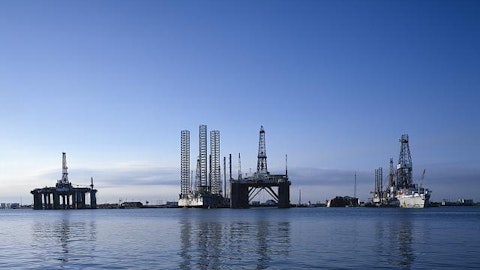Fluor Corporation (NYSE:FLR) Q3 2023 Earnings Call Transcript November 3, 2023
Operator: Good morning and welcome to Fluor’s Third Quarter 2023 Earnings Conference Call. Today’s call is being recorded. At this time, all participants are in a listen-only mode. A question-and-answer session will follow management’s presentation. A replay of today’s conference call will be available at approximately 10:30 a.m. Eastern Time today. Accessible on Fluor’s website at investor.fluor.com. The web replay will be available for 30 days. The telephone replay will also be available for seven days through a registration link. Also accessible on Fluor’s website at investor.fluor.com. At this time, for opening remarks, I’d like to turn the call over to Jason Landkamer, Head of Investor Relations. Please go ahead, Mr. Landkamer.
Jason Landkamer: Thanks Jordan. Welcome to Fluor’s 2023 third quarter earnings call. David Constable, Fluor’s Chairman and Chief Executive Officer; and Joe Brennan, Fluor’s Chief Financial Officer, are with us today. Fluor issued its third quarter earnings release earlier this morning and a slide presentation is posted on our website that we will reference while making prepared remarks. Before getting started, I would like to refer you to our Safe Harbor note regarding forward looking statements which is summarized on Slide 2. During today’s presentation, we will be making forward-looking statements which reflect our current analysis of existing trends and information. There is an inherent risk that actual results and experience could differ materially.
You can find a discussion of our risk factors, which could potentially contribute to such differences, in our 2022 Form 10-K and in our Form 10-Q, which was filed earlier today. During the call, we will discuss certain non-GAP financial measures. Reconciliations of these amounts to the comparable GAAP measures are reflected in our earnings release and posted in the investor relations section of our website at investor.fluor.com. I’ll now turn the call over to David Constable, Fluor’s Chairman and Chief Executive Officer. David?
David Constable: Thank you, Jason. Good morning, everyone. And thank you for joining us today. Please turn to Slide 3. In response to investor inquiries from our shareholders, I wanted to provide some insight into how Fluor is leveraging artificial intelligence technologies across the organization. As some of you may recall, in 2018 we had entered into an industry exclusive partnership with IBM to develop a predictive analytics solution for large projects. Based on a significant database of over 200 projects spanning 20 years, we continue to expand the use of this platform to supplement execution across our portfolio. At the same time, we launched a parallel effort to create an AI platform to provide predictive pricing on materials for our supply chain.
Outside of these two major predictive solutions, Fluor is currently using over 60 AI-derived platforms across IT, tax, treasury, human resources, proposal development, and plant and facility services. This is in addition to a number of simulation and rule-based AI enabled systems that we have deployed to support project execution. These systems are helping Fluor reduce costs and drive a data-driven decision-making process that leads to better project management and quality control. Now let’s turn to our operating review beginning on Slide 4. Revenue for the third quarter was $4 billion, representing our third straight quarter of 10% growth over the prior year. Our increase in revenue was led by Urban Solutions, as we ramp up execution activities on several recently awarded projects, including a large metals project in the U.S., two life sciences projects, and a semiconductor project.
Consolidated new awards for the quarter were $5 billion, remaining on track relative to our full year plan of a book-to-burn ratio of greater than 1 times. New awards were 94% reimbursable, and our total backlog is now $26 billion, of which, 70% is reimbursable. We continue to see strong demand for our services and the value we provide. Margins on new awards were 70 basis points above the margin profile of our existing backlog. The demand for our services is evident by our prospect pipeline. We continue to track a slate of prospects that is more than 15 times the size of our current backlog. This is led by opportunities in chemicals, closely followed by production in fuels, and mining and metals. As you will see over the next few slides, our financial discipline, combined with our focus on selectivity and project execution, are starting to drive consistent results.
Moving to our business segments, please turn to Slide 6. Urban Solutions reported a $66 million profit in the third quarter. Results included an incentive fee earned on a large mining project that is nearing completion, as well as a favorable arbitration outcome on a separate mining project. New awards for the quarter were $1 billion, and ending backlog is now $11.1 billion and 59% reimbursable. Now please turn to Slide 7. In mining and metals, we continue to work on a number of front end studies, including critical minerals production and green steel technologies. Although there have been no cancellations, the industry has been carefully monitoring inflation inputs and commodity pricing. We’re now starting to see clients move forward with final investment decisions.
Earlier today, we announced a multi-billion dollar reimbursable award from BHP for Stage 2 of their Jansen Potash Project in Canada. This award will be recognized into backlog in the fourth quarter. Looking ahead to the first half of 2024, we see significant opportunities in lithium, steel, and copper to bring into backlog. Moving to Slide 8, our Advanced Technologies and Life Sciences business Line had another active quarter. Last month, we announced the completion of Bayer’s first global cell therapy launch facility. This new state-of-the-art biopharmaceutical development and manufacturing facility will be used to produce cell therapies for neurological degenerative disorders, cardiovascular disease, and other current unmet medical needs.
On the new awards front, ATLS was able to build off its successes in the second quarter. This includes an initial award for a semiconductor facility in the Pacific Northwest and an award north of $400 million for an expansion facility for a key strategic customer in Denmark. We were also awarded a feed package for Altris AB for the world’s first industrial scale sodium ion battery production facility. We are excited about the pipeline of reimbursable opportunities in this business line. Over the next few quarters, we are positioned to win significant additional semiconductor work and multi-billion dollar opportunities in life sciences. In infrastructure, we continue to make significant progress on legacy and non-legacy projects during the quarter.
On the Gordie Howe project, we had a very productive summer with great progress on the bridge and the US and Canadian ports of entry. In August, the team celebrated the topping off of the US tower at 722 feet. The project is now 65% complete. As we mentioned last quarter, Fluor, along with our partners, continue to have collaborative discussions with the Gordie Howe client with respect to cost and schedule relief. Our joint venture team is working to resolve these discussions in the next few months. Moving on to Slide 9. Mission Solutions reported a segment profit of $38 million for the third quarter compared to $29 million a year ago. Results for the quarter reflected increased execution activities for FEMA hurricane support. New awards for the quarter included the $175 million four-month extension at Portsmouth, a new award for AFRICOM under our LOGCAP V contract, and additional task order awards under our FEMA contract to support hurricane-related efforts in Florida and Georgia.

Last month, we were also informed that our contract for the NNSA’s Naval Nuclear Propulsion Program was extended for five years through 2028. Fees from this $8.5 billion extension will be recognized as equity income. During the quarter, our team submitted our bid package to the NNSA for the Pantex Management and Operations Contract. This contract includes a five-year base period with three five-year options valued up to $30 billion over 20 years. We expect to have an update on this contract next year. Moving to energy solutions, please turn to Slide 10. Segment profits significantly improved to $177 million from $59 million a year ago. Results reflect the initial recognition of cost recovery entitlements on several fixed-price projects, partially offset by cost growth on a large upstream legacy project and a charge for the expected net settlement of a long-standing claim.
Results also included a $24 million gain on our embedded derivative in Mexico. New awards for the quarter totaled $3.3 billion and included a confidential reimbursable EPCM contract for a large chemicals project in North America. For the fourth quarter, we are anticipating some sizable reimbursable new awards. Prospects include a large battery chemical project and an isocrafter retrofit project, both in Europe and an LNG facility in Indonesia. Finally, I’d like to note that LNG Canada is now 88% complete and this project continues to meet management expectations. Before I turn the call over to Joe, I want to note that our results and accomplishments this quarter reflect notable progress against our corporate strategy and is indicative of our ongoing transformation into one of the leading engineering construction companies in the world.
With that, let me turn the call over to Joe for the financial update. Joe?
Joe Brennan: Thanks, David, and good morning, everyone. Today I will review our results for the third quarter, highlight some of the key capital structure activities that were recently executed, and go over financial outlook assumptions that support our revised guidance. Please turn to Slide 12. As David mentioned, for the third quarter of 2023, revenue was $4 billion, a 10% increase from last year. Revenue for the quarter was driven by the ramp up of execution activities on several recently awarded projects across all three segments. Our consolidated segment profit for the quarter was strong at $276 million. This performance was driven by higher execution activity, as well as the initial recognition of cost recovery entitlements on several fixed price contracts.
Adjusted EBITDA for the third quarter was $216 million compared to $30 million a year ago. Our adjusted EPS was $1.02 compared to $0.07 in Q3 of 2022. Our adjusted results for the quarter exclude $47 million for the positive income effects of FX and the embedded derivative in Mexico. G&A expenses for the quarter were $56 million, up from $30 million a year ago. This was driven by higher performance-based compensation forecasts, including stock price influence compensation, which is expected to be paid in Q1 of 2024. Net interest income in the quarter was $42 million, compared to $37 million last quarter and $14 million a year ago. Our reinforced liquidity position will enable us to generate positive net interest income throughout the year with prevailing interest rates on our deposits and marketable securities.
New awards of $5 billion in the quarter improved our ending backlog balance to $26 billion. Based on our prospect pipeline for Q4 and as David advised earlier, we anticipate a book-to-burn ratio in excess of 1 times for the full year. Moving on to Slide 13. Our cash and marketable securities balance for the quarter was $2.4 billion. This excludes amounts held by NuScale. As it relates to operating cash flow, we expect to be positive for the full year. This includes additional distributions from our joint venture arrangements in Mexico and Canada, which more than covers the cash needs for legacy projects. Any potential client concessions on the Gordie Howe project are not currently included in our cash flow outlook. While we are not discussing 2024 guidance on this call, I do think it is important to note that we expect 2024 to be a significant year for cash flow generation as we start to see meaningful contributions from our growing non-legacy portfolio.
During the quarter, we reached an agreement to sell Stork European businesses to Bilfinger. We have also launched an effort to transact Stork’s remaining operations. At this point, we expect all transactions to close by Q2 next year. Now, please turn to Slide 14. In August, we completed a very successful convertible debt offering to address our December 2024 senior notes. As a result of our offering being oversubscribed by 5 times, we were able to lock in a coupon rate of [1.18%] (ph) and a conversion premium of 32.5%. We also entered into cap call transactions that prevent any shared dilution until our share price trades above $68. Including the cost of the cap call, our effective cost of this debt is approximately 3.47%, slightly lower than the 3.5% December 2024 notes we are retiring.
If we had pursued a straight debt issuance, we estimate our cost of funds would have been more than double this market-leading effective rate. A simplified example of how the cap call transaction works can be found in the appendix section of our slide deck. I should note that in advance of retiring the 2024 notes, the proceeds from the offering have been primarily invested in securities yielding over 5%, outearning our maturing fixed rate debt of 3.5% by over 150 basis points. Lastly, in September, we announced the full conversion of our convertible preferred stock, which further simplifies our capital structure. The cost of this conversion was $27 million, approximately $2 million less than the remaining undiscounted mandatory dividends. We will not have any change to our adjusted EPS estimated calculations as these shares were already reflected in our share count.
And now that our 10-Q has been filed, our market cap will adjust upward by more than $1 billion. With these transactions, we have rebuilt a capital structure that was pressured over the past few years as we transition back into a lower-risk portfolio. Please turn to Slide 16. We are raising our full year 2023 adjusted earnings per share guidance to a range of $2.50 to $2.70 and increasing our adjusted EBITDA guidance to approximately $600 million. Our assumptions for the fourth quarter include: revenue of more than $4 billion; adjusted G&A expense of approximately $50 million, and an effective tax rate of approximately 40%. This may vary depending on countries in which revenue is generated. We expect tax rates to moderate as revenue in our tax advantage locations start to increase.
Our expectations for Q4 segment margins are: approximately 4% to 4.5% in energy solutions, approximately 4% in urban solutions, and approximately 6% in mission solutions. Finally, we also reaffirm our 2026 adjusted EBITDA guidance of $800 million to $950 million, as indicated in our earnings release this morning. Operator, we are now ready for our first question.
See also 30 Must-See UNESCO World Heritage Sites and 20 Most Famous Breweries in the US.
Q&A Session
Follow Fluor Corp (NYSE:FLR)
Follow Fluor Corp (NYSE:FLR)
Operator: Your first question comes from the line of Steven Fisher from UBS. Your line is live.
Steven Fisher: Great. Thanks. Good morning and good to see the backlog growth there with the cost-reimbursable mix. There were a lot of one-offs in the segment this quarter, though, related to older projects. And the language in the release said that you had initial recognition of cost recovery entitlements. So I guess I’m curious if that means there’s going to be more of those benefits coming in? How consistent might the recognition be and what did you bake into the guidance for that?
Joe Brennan: Thanks, Steven. The — principally what’s driving some of the recognition relative to that is the activities in Mexico. And the way I’m looking at the recovery of those costs are really through the financial discipline and the execution as we drive to more positive conclusions on some of our lump sum projects. And it’s a process. It clearly was part of our entitlement in our contract, but we had to work our way through it. So there’s a portion of that. We always had it outlooked in Q4, but we were able to recognize it in Q3. So it was part of our guidance overall, but I think the majority of those projects now are close to 90% complete. So I do not expect to see that type of significant uptick in a recognition around these cost recoveries going forward.
Steven Fisher: Okay. That’s very helpful. And just, I guess, bigger picture macro. I think, David, when you were talking about the mining activity, you mentioned there was no cancellations and things moving forward. I guess I’m just curious about related to the stronger for longer interest rate environment. But what do you hear from your customers about the impact of that? Does that kind of create opportunities for you to do more value engineering? Are there any delays? Is your project set pipeline looking more insulated? What do you think about sort of that big picture macro topic? Thank you.
David Constable: Good morning, Steven. It’s David. From a mining and metals perspective, as you just saw, we had a great award here from BHP earlier this morning up in Saskatchewan for their Potash plant. A great client with a long relationship with BHP due to our project execution performance with them. So, it was great to see that. More generally, we’ve got about $55 billion of front-end work ongoing in mining and metals right now. We see that continuing and have another line of sight on about another $50 billion of front-end work. Obviously, value engineering is also always important across our client base to make sure we can drive the best value and the right solutions for our customers. Mining clients are, big picture, investing in energy transition minerals and metals.
We see that continuing. Some of the mid-tier clients are not going after the big multi-billion dollar projects, but their CapEx levels, we track our clients’ CapEx levels quarterly, and we don’t see that softening at all right at this point. And with all that front end work, we continue to remain confident in our mining and metals business and especially being such — on copper specifically, being the leader in the copper mining space, we feel we’re in a really good position going forward.
Steven Fisher: Terrific. Thank you very much.
David Constable: Thank you.
Operator: Your next question comes from the line of Andrew J. Wittmann from Baird. Your line is live.
Andrew J. Wittmann: Great. Good morning. I thought I would ask here, Joe, to cut through the noise as much as we would all love to hear and quantify the claim settlement, the upstream charge, and the various other things that ran through your income statement this quarter. I know that you’re not going to do that for us. So I’m going to ask that question in aggregate a different way. And so your adjusted EBITDA for the quarter was $216 million. You previously talked about your run rate of EBITDA and have demonstrated, in fact, the last several quarters of around $150 million of EBITDA. Was the quarter’s results, if you would look at it, kind of ex the big items that you called out in your release in that $150 million run rate range, or was it different from that?



